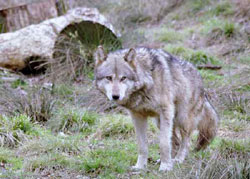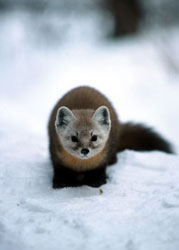
PREDATORS AND PREY
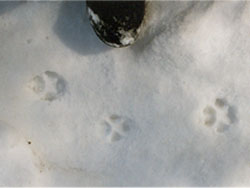
By its topographical situation and passes, the Trient Valley is a main point of passage for transiting and migrating wildlife while its environment is healthy and wild enough to support a thriving resident population.
The “Big” Predators: Wolves and Lynx
Contrary to the lynx, which was re-introduced after having been exterminated, the wolf is repopulating the country naturally from the east (the so-termed “Siberian” wolf) and from the south (the so-termed “Italian” wolf.)
The present situation for wolves:
All passions set aside and considering facts only, attacks on flocks of sheep by wolves and, more frequently, by feral dogs, are always disastrous in the Alps. This is due to three factors:
(1) Sheep’s instinct to flock and stampede in blind panic.
(2) Wolve’s method of weeding out the weakest by pursuit or, worse, the purposeless instinct to pursue of domestic and feral dogs, and
(3) The steep, accidented terrain. Whole flocks have been driven off ledges or tumbled down slopes too steep, with disastrous consequences not only for the sheep and owners but for wolves as well, as opposed to the damage limited to the sheep wolves kill on flat land.
Nowadays, fortunately, most owners realize that not all canid attacks are, by far, due to wolves and, by law, all attacks are carefully investigated by wildlife professionals before any culprit is designated and action of any sort is taken. In Switzerland a wolf is allowed a maximum kill of forty sheep in its lifetime; if it exceeds that limit it is declared ‘too destructive’ and shot. Otherwise, it is forbidden to harm a wolf in anyway.
At present, after trying several types of fencing which often proved ineffective on alpine terrain and an impediment to wildlife in general, there is a return to age-old methods of cohabitation that are more wildlife friendly and take into account the behavior of both prey and predator; i.e.: using trained sheepdogs to guard bigger flocks, putting donkeys with small flocks, putting a bull in with a small, isolated herd of cows, replacing actual breeds with hardier, ancient breeds (pro species rara) or ornery alpacas. Some owners in the gentler Jura Mountains have even opted for buffalo or highland oxen. To promote cohabitation the government and conservation groups compensate livestock owners in full for the animal and the added value (wool, milk/ by products) it could have generated. However, in the Alps where terrain limits the livestock it is able to support, most herding is subsistence level and herds and flocks tend to be small with owners knowing each of their animals by name and often developing bonds with them. Where sentiments come into play, money cannot compensate. Animosity towards wolves, mostly among sheep owners, is still strong, especially in areas where there have been recent or massive kills. Though no longer in use, an ancient wolf-pit trap still exists near the valley’s main village; a reminder of past times and present feelings.
There have been several wolf sightings in the valley in the past years. At the time of this writing a wolf was reported in the nearby Val de Bagne while farther east another exceeded its allowed kills and was sentenced to be killed in turn. Having no desire to see posses of hunters roaming around, the presidents of both communes agreed that only local citizens could hunt, no helicopters or posses, just a few men on a mountain looking for a lone wolf that, in fair play, got away.
Local feelings toward lynx attacks are much more tempered. When asked why, the answer given is that a lynx’s hunting methods, a single, focused strike on an isolated, sick or wounded animal, makes them less destructive and, therefore their attacks accepted as “culling”.
There have been attacks on the nearby village’s sheep flock limited to an animal that was sick, one that got caught in fencing and a weak newborn lamb, which generate no compulsion to go hunt down the culprit. It is among hunters, who claim the lynx takes too many deer and chamois that resentments exist. These, however, seem to be unfounded, thousands of deers and chamois having been shot within the 2006 hunting season alone. Lynx do occasionally attack pets in which case conservation groups compensated owner, until the federal government and states assumed the charges.
To resume, there is a genuine, practical effort being made by the government, conservation groups, livestock owners, wildlife professionals and the Swiss themselves, to find a viable means of cohabitation for all.

|
||
|
|
|
|
Wolf |
Lynx |
|
|
|
||
The Preys
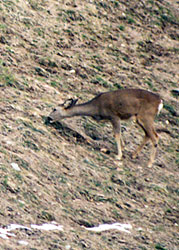 |
|||||||||
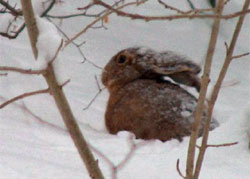 |
|||||||||
Hare |
|||||||||
Other Prey:
|
|||||||||
Roebuck |
|||||||||
Ungulates are very present in the valley. Distributed according to altitude, chamois and bouquetins (ibex) are found highest up, roebuck and deer are lower where, occasionally, there are wild boars. It is not uncommon to be startled by deer crossing the trails in the vicinity of the Wild Associations premises; but to observe chamois and bouquetins a hike above tree level is necessary; however, in the dead of winter they can be seen across the valley from the premises. Some Swiss nature enthusiasts wait for deer mating season just to enjoy the majesty of the deers’ mating call from a respectable distance; usually the opposite side of the valley.
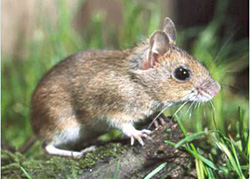
Field Mousse
We draw your attention to the fact that winters are very harsh on wildlife, especially at higher altitudes, where an animal must expend great stores of energy just to move through the deep snow. For this reason we ask that should you accidentally startle an animal, it is important to remain still for the time needed to give no impression of pursuit: it could make the difference between life and death for it.
Thank you.
